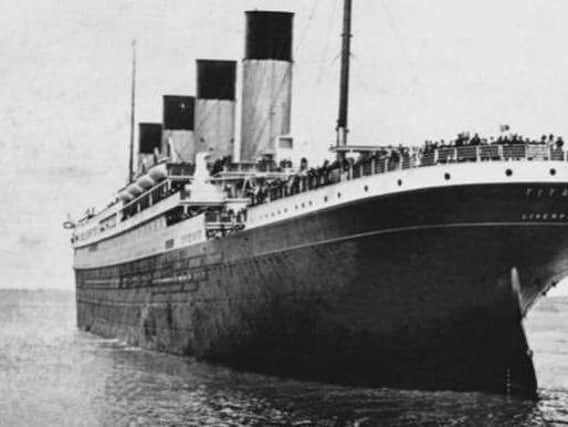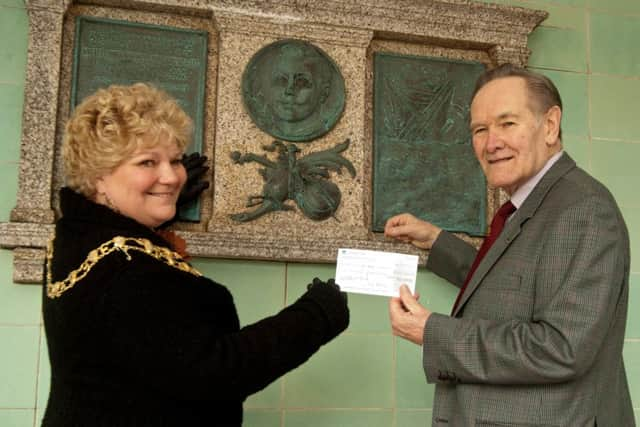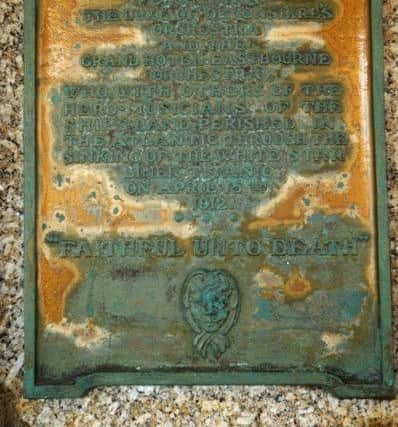NOSTALGIA: Titanic musician's link to Eastbourne


Mr Clark was himself a ships’ radio officer for many years serving on and during crossing the Atlantic on the Queen Mary.
He told some of the story from the radio operator’s perspective and started his talk with a map tracing the route of that fated voyage that the Titanic took across the Atlantic.
Advertisement
Hide AdAdvertisement
Hide AdThe Titanic, launched in 1911, was owned by the White Star Line and built, together with sister ships the Olympic, launched in 1910, and Gigantic, which was actually named Brittania when she was launched in 1914, at the facilities of Harland and Woolff in Belfast.


He spoke of the catalogue of problems that assailed the Titanic from the very beginning – some of which may have led to her eventual sinking after hitting an iceberg on her maiden voyage.
It started when the Olympic had been launched and was badly damaged in a collision with another ship and had to return to the shipyard for repairs. This delayed the completion of the Titanic as the workers were taken from her to repair the damaged ship.
By the time Titanic was completed and ready for her maiden voyage on April 10 1912, there was a strike in progress which meant she couldn’t easily obtain coal for her boilers. Coal was loaded in Belfast at the start of her voyage but it caught fire in the holds near the bow of the ship and carried on smouldering throughout the voyage.
Advertisement
Hide AdAdvertisement
Hide AdMore coal had to be scraped together from other ships when she reached Southampton for her maiden voyage to take place as advertised.


The fire in the hold possible weakened the steel plates of her hull and watertight bulkheads.
Later there some concern was raised about the quality of the steel plates and rivets used in her construction and whether it had been adequate. Also the steel became brittle when exposed to very cold temperatures and exacerbated the impact damage.
The captain, Edward Smith, was very experienced. Most of the crew were casual workers from Southampton as it was normal at that time not to have permanent crew.
Advertisement
Hide AdAdvertisement
Hide AdA great proportion of her passengers were emigrants travelling steerage or third class who were kept entirely separate from the wealthier passengers.


Her passenger list comprised First class: 735, Second class: 674, Third class: 1026 and a crew of 885.
Even as she left port there was a problem as turbulence due to her great size caused another ship to move and break the rope securing it to the dock and there was nearly another collision.
The ship was travelling at almost full speed as they could save coal by travelling fast.
Advertisement
Hide AdAdvertisement
Hide AdAt 9pm the ship received a warning about icebergs in the area. At 23.40pm on April 14 a lookout spotted an iceberg. It was too late and they were going too fast. They tried to take avoiding action but the side of the ship scraped the side of the iceberg and severely damaged the hull plates near the bow – the same area where the coal had been smouldering.


Thomas Andrew who had designed the ship was on board and after an inspection stated that the bow compartments were flooding and the ship would sink in two hours.
A distress call was sent out by the radio operators at 00.45am on April 15. First they used the code CQD (Come Quick Distress) then for the first time ever by a passenger liner changed to SOS. There was a ship within 16 miles of the Titanic but when it saw the distress flares it was thought they were having a party on board so it didn’t respond.
The Carpathia was 58 miles away but did respond and saved about 710 people.
Advertisement
Hide AdAdvertisement
Hide AdThe radio operators Jack Phillips and Harold Bride (one survived the disaster) were very busy with calls being made by the passengers and possibly missed some of the iceberg warnings being broadcast over the radio although some were received and passed to the bridge.
Mr Clark then told of the situation on board and the problems evacuating the ship. There were 20 lifeboats of various forms capable of holding 1,178 persons but there were 2,208 on board. This figure was acceptable under the Board of Trade Regulations at the time.. Due to the usual method of asking women and children to get into the lifeboats first, which many of them were for some reason reluctant to do so, and this contributed to the loss of life as many of the lifeboats were not filled to their carrying capacity.
Many of the third class and steerage passengers were locked down inside the ship until the last minute when it was too late for them to escape to the lifeboats.
John Wesley Woodward was one of the ship’s musicians. He had formerly been a member of a number of orchestras including that of the Grand Hotel, Eastbourne. He and fellow musicians played bravely out on deck to try to calm the passengers as the ship was sinking and lost their lives doing so.
Advertisement
Hide AdAdvertisement
Hide AdThe orchestra had to remember all the notes for 341 tunes and the leader called out a number of the music to be played and they immediately started playing the appropriate music - a feat of memory indeed.
The afternoon finished with questions and a display of items about the Titanic as well as a model of the liner being made by Mr Clark. It was a very interesting and enjoyable talk.
The next meeting which will be at All Souls Church Hall, Wellesley Road, Eastbourne, on Tuesday September 26 at 7pm with a talk by Giles Dawkins entitled ‘The Evolution of the Marsh-side Settlement of Pocock’s Field’. The doors are open 15 minutes before the start of the meeting. Visitors and guests are very welcome for a £2 donation. For further information please contact Diana Guthrie 419181.